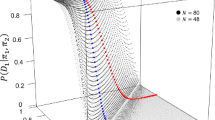Abstract
In this paper we discuss a behavioral Bayes approach to the sample size question in clinical trials with binary responses for which the central limit theorem cannot be applied to provide an adequate approximation of the size of a trial. A fully Bayesian framework is considered. The optimal sample size is obtained by maximizing the expected net benefit, which is the benefit from subsequent use of the new treatment under consideration minus the cost of the trial. The regulatory requirements for granting a licence to the new treatment are discussed. It is shown, not surprisingly, that the optimal sample size depends strongly on the expected benefit from a conclusively favorable outcome, and on the strength of the evidence required by the regulator. Conventional approaches to the question ignore the trade-off between costs and benefits.
Similar content being viewed by others
References
Lemeshow S, Homser Jr. DW, Klar J, Lwanga SK. Adequacy of Sample Size in Health Studies. Chichester, England: John Wiley and Sons; 1990.
Raiffa H, Schlaifer R. Applied Statistical Decision Theory. Boston, MA: Division of Research Harvard Business; 1961.
Lindley DV. The choice of sample size. Statistician. 1997;46:129–138.
Stallard N. Sample size determination for phase II clinical trials based on Bayesian decision theory. Biometrics. 1998;54:279–294.
Pezeshk H, Gittins JC. Sample size determination in clinical trials. Student. 1999;3(1):19–26.
Gittins JC, Pezeshk H. A behavioral Bayes method for determining the size of a clinical trial. Drug Inf J. 2000;34(2):355–363.
Gittins JC, Pezeshk H. How large should a clinical trial be? Statistician. 2000;49(2):177–187.
Spiegelhalter DJ, Freeman LS, Parmar MKB. Bayes-ian approaches to randomized trials, J R Statist Soc A. 1994;157:357–416.
Coad DS, Rosenberger WF. A comparison of the randomized play-the-winner rule and the triangular test for clinical trials with binary responses. Stat Med. 1999;18:761–769.
Pham-Gia T, Turkkan N. Sample size determination in Bayesian analysis. Statistician. 1992;41:389–392.
Wolfram S. Mathematica: A System for Doing Mathematics by Computer. Redwood City, CA: Addison Wesley; 1991.
Author information
Authors and Affiliations
Corresponding author
Rights and permissions
About this article
Cite this article
Pezeshk, H., Gittins, J. A Fully Bayesian Approach to Calculating Sample Sizes for Clinical Trials with Binary Responses. Ther Innov Regul Sci 36, 143–150 (2002). https://doi.org/10.1177/009286150203600118
Published:
Issue Date:
DOI: https://doi.org/10.1177/009286150203600118




